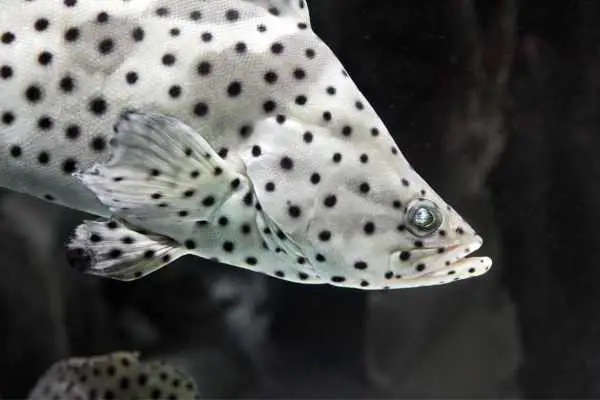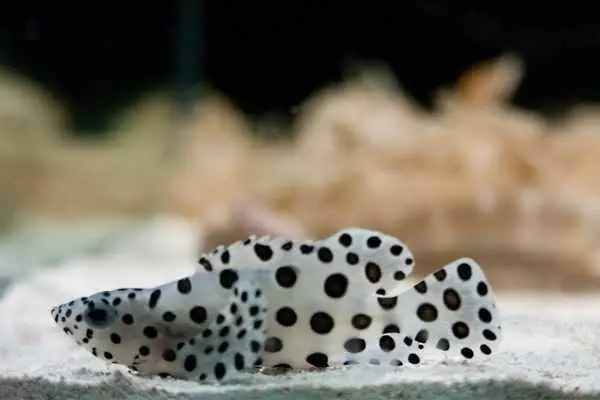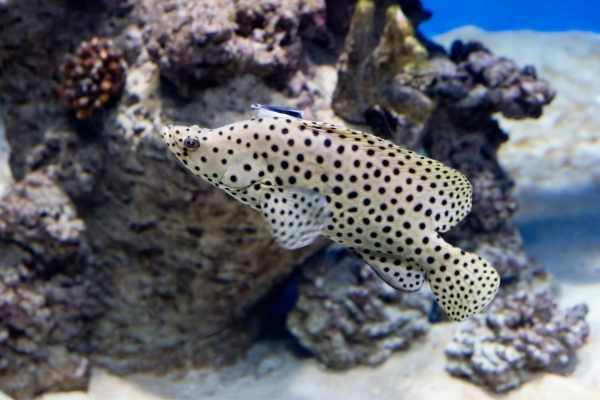Panther groupers (Cromileptes altivelis) lure in plenty of aquarists. They look stunning in their dalmatian coats of white and black. And when fish stores stock them, they seem harmless enough. Of course, no one mentions those spotted groupers are juveniles. If you haven’t done your homework, you quickly find yourself struggling to keep up as your fish grows…and grows…and GROWS. Good thing you’re reading this now to prepare yourself in advance of bringing one home!
Table of Contents: Panther Grouper Care
Now, you COULD skip ahead to figure out exactly how large a tank you’re going to need for your panther grouper. These links walk you through all of the pieces of their care. However, if you want to make sure you’re getting all the information, it’s probably best to read the entire article.
- Quick Facts
- Description of the Panther Grouper
- Panther Grouper Lifespan
- Creating the Ideal Panther World
- Panther Grouper Diet
- Panther Grouper Behavior and Tank Mates
- Breeding the Panther Grouper
- Pros and Cons
- For More Information

Quick Facts
- Common Names: Panther grouper, Panther fish, Polka dot grouper, Humpback grouper, High-fin grouper, High-finned grouper, Mouse grouper, Seabass (Likely misidentification), Barramundi cod (in Australia)
- Scientific Name: Cromileptes altivelis
- Size: Up to 27 inches (68.6cm)
- Minimum Tank Size: 300 Gallons (1136L)
- Reef Safe? With Caution
- Care or Experience Level: Moderate
- Preferred Diet: Carnivore
- Original Part of the World: Indo-Pacific AND Invasive off Florida
Description of the Panther Grouper
Swimming happily around in the fish store tank, panther groupers stand out from the school. Catch them under the proper lighting, and the white background scales shine with an iridescence. Then, of course, you have the black spots for which they get their names. They have a narrower head than one expects from a grouper, and it takes off at the neck, creating a “humpback.” (This is why you also see them called humpback groupers) The dorsal fin starts from the “hump” and follows nearly the entire body.
Sure, that makes the fish look a little funny, trying to maneuver its oversized fins, but you know they’ll grow into them eventually. Which they DO. When panthers reach full size, they stretch an impressive 27 inches (68.6cm) in length! And they grow quickly. You’ll see them extending a few inches PER MONTH. They also start to change their coloring. The adults take one a duller tone, with more green to the white scales. The fins adopt bluish shades, as well. You’ll still see those black spots, though. And when panther groupers get stressed?
You see patches of brown form over their scales. It’s known as fright coloration. This pattern allows them to blend in with their natural environment. (Since white isn’t the best option for camouflage) However, like monsters in the average marine aquarium, if YOU see the color develop, it’s a warning that something’s not right in the system.

Panther Grouper Lifespan
Panther groupers scatter across the Pacific from the southern tip of Japan to Queensland, Australia. They’re hardy and adapt to change within their environment. Unfortunately, that’s also allowed them to happily set up home off the Atlantic coast of Florida and throughout the Gulf of Mexico. Invasive panthers resulted from aquarists releasing them into the wild when they struggled to maintain their rapidly-growing fish, rapidly-growing, AND long-living. The average panther grouper has no problem surviving over TWENTY years. As such, it’s essential to understand the commitment you’re making when you take one on for your marine tank.
They continue to find their way into the Atlantic and Gulf, where they’re poised to become a similar threat to the lionfish, crowding out native populations of reef fish. Florida now holds “Pet Amnesty Days” to encourage aquarists to turn in their panther groupers without fear of a charge or citation.
Creating the Ideal Panther World
Panther groupers prefer to swim in coral reefs and tide pools ranging in depth down to 130 feet (40m). They’re often collected from the reef environment while still juveniles and “manageable” size of only 3-4 inches (7.6-10.2cm). The larger adults serve as a food source throughout the eastern Indian Ocean, Palau, and New Caledonia. (Clearly, you’re not interested in snacking on your new acquisition, but it’s important to understand the species) An active fish, panthers swim in and out of the landscape. Their massive size still makes them a target for LARGER predators, though. And you’ll need to make sure you provide them places to hide.
The best way to do this? Live rock. Panther groupers don’t need the live rock as sustenance, but the natural contours mimic the reef they prefer. The stone also generates shaded regions within the tank. You DO see panther groupers in shallower waters, but they also dive into the depths. And while they explore all the tank levels, they often come to rest near the bottom. Setting up ledges and caves that allow them to settle out of the light will make them more comfortable.
You don’t need to worry about the particular substrate or plants you set up within the reef tank. Panthers don’t show a preference. (Though you want to consider the needs of the other fish you’re keeping) However, you DO need to take care with your filtration. Panther groupers produce enormous amounts of waste. They’re NOT small fish, and they don’t do anything on the small size. If you don’t keep up on maintenance, you will see a deterioration in your water parameters and then disease.
You’ll need an oversized protein skimmer and AT LEAST two canister filters to keep up. And while you may get away with following the instructions with most fish, panthers are an exception. To ensure your tank stays clean, you’ll need to clean the filters TWICE as often. Otherwise, your groupers (and everyone else) may end up sick.

Panther Grouper Tank Size
When people spot that white and black pattern in a fish store, they don’t realize how large the panther grouper will get. The juvenile looks easy to manage. And it is – but not for more than a couple of months. Unless you plan to buy more and MORE tanks, you need to start prepared to handle the adult from the beginning. A minimum of a 300-gallon (1136L) tank is necessary for these monsters. And that’s ONE panther grouper! If you entertain a pair or school (good luck!), you need to go even LARGER. For this reason, the average aquarist doesn’t keep these fish. (Or they end up trooping to a “Pet Amnesty Day”) You usually only see them in professional aquariums or zoological institutions.
Are Panther Groupers Reef-Safe?
In a rough sense of the term, panther groupers are reef-safe. They’re carnivores, but they don’t feed on corals or sea anemones. They WILL go after any crustaceans or mollusks you attempt to place in your reef tank, however. And they’re accomplished hunters. Also, as they settle into their shaded resting places, they may brush against coral polyps. However, they don’t usually damage the coral in the process. So it comes down to whether you feel your shrimp, snails, and crabs count as part of your “reef” environment or not.

Panther Grouper Diet
Panther groupers enjoy meat and plenty of it. It makes them interesting to watch at feeding time, but it also stresses your tank’s cycle if you fail to set up the proper filtration. And if you don’t offer them enough food? They’ll start hunting their tank mates for sustenance. (Not fair, when you think about it) Your best bet to keep everyone happy, healthy (and not eaten) is to provide the proper amount of meaty chunks of marine-origin food. This means feeding three times a day when you have that cute little juvenile, backing off to ONCE a day when they reach their “teenage” years, and slowing down to 2-3 times a WEEK when they’re adults. Good choices of food include:
- Crab
- Krill
- Mussel
- Shrimp
- Silversides
- Squid
Whether you decide to go frozen or live is up to you. Avoid anything pre-cooked from YOUR meals, though. Pre-cooked seafood lacks the nutrients panthers need to stay healthy. And the same goes for feeder goldfish. Goldfish are freshwater species, and they won’t have the nutrients a grouper would need for their immune system. You don’t want your panther grouper to succumb to illness.
Panther Grouper Behavior and Tank Mates
Groupers behave similarly to tangs: they don’t like one another. If they see another panther grouper or something that looks like a grouper, they get defensive and start an attack. And since they ARE brutes in the size department, it doesn’t usually end well. Also, since you’re already breaking the bank in the tank size department, odds are you won’t be trying to add more than one in the first place. (Because you read this handy guide and realized how massive your panther grouper was going to get) However, there IS a way to add other groupers to a tank with a panther grouper.
You get everyone at one time when they’re small, cute, and cooperative. Juvenile fish usually tolerate one another better than adults. And since they’ll already recognize each other, they’ll grow up and learn to share the marine tank without a problem. It means a bunch of small fish swimming around a vast, cavernous aquarium for a while. But once everyone grows into their fins, you’ll have a stunning display. If you’re looking to mix things up, though, you need to think things through. Panther groupers are predators.
If something fits in their mouth? They’re going to eat it. However, you have a bit of a break. Unlike most groupers, panthers have a mouth on the smaller side. It doesn’t mean you can put ANYTHING in with them, but it means you have some wiggle room. Workable tank mates include:
- Anglerfish
- Butterflyfish
- Damselfish
- Eels
- Lionfish
- Pufferfish
- Sharks
- Tangs
- Triggerfish
- Wrasses
When you’re not sure whether or not a fish WILL fit in your panther grouper’s mouth, take it slow. If you purchase and set up a divider made of plexiglass, you can observe how your panther reacts. Seeing the grouper repeatedly try to chow down on the new tank mate lets you know it’s much too small. No reaction? You’re probably in the clear. As to invertebrates? Panther groupers LOVE them. And there’s nowhere in a reef tank they can hide that your panther won’t find them. The fish DOES prefer to swim in the middle and upper regions of the water column, but they rest on the bottom. You may want to skip the shrimp and opt for fish-based cleaners instead.

Breeding the Panther Grouper
When it comes to figuring out whether you have a male or female panther grouper, you’re a little out of luck. They don’t look different. And since they’re a protogynous hermaphrodite species, it gets even more complicated. This is a particular form of sequential hermaphroditism where all fry are born female. Then the largest in a region transition to male. As for breeding panther groupers? Yeah, you can TRY, but the odds aren’t in your favor.
One attempt – with artificial propagation – was made way back in 1979. And while the pair DID spawn, the resulting fry died within a week. And since then? No one’s managed it with any real success. Probably because it involves tank sizes that border on insane. And the average aquarist? They simply don’t have access to that kind of room. In the wild, panther groupers scatter their eggs into the open water. The eggs ARE buoyant and drift with the current. Beyond that? No one knows much. And the lack of information doesn’t help with duplicating the breeding process in captivity. For now, aquarists rely on collection from the wild.
Pros and Cons
With their striking dalmatian spots, it’s hard to resist panther groupers. However, as with any stunning saltwater fish species, you need to consider all of the pros and cons before you bring one home:
Pros
- Panther groupers are easy-going about their tank décor, provided you allow for live rock to explore and space with shading for them to rest within.
- Despite their predatory nature, panther groupers have smaller mouths than others in the grouper family, allowing you to pair them with more potential tank mates.
- When stressed, panthers change color with brown patches, providing you with an “early warning system” that something’s wrong.
Cons
- Panther groupers rapidly grow from 3 inches (7.6cm) as juveniles to 27 inches (68.6cm) as adults, quickly expanding beyond their tanks.
- Wild-caught panthers often carry parasites with them – sometimes up to SIXTEEN different species!
- As carnivores and accomplished hunters, panther groupers WILL consume your mobile invertebrates.
For More Information
Despite the massive size the adults reach, panther groupers still enchant aquarists. And as long as you do your homework and make the proper preparations? There’s no reason you can’t add one to your marine aquarium. So why not dive a little deeper with some more information? This YouTube video shows a panther grouper eating a lancefish (and demonstrating why you pay attention to the size of that mouth!).
Want to learn more about the best panther grouper tank mates?
- Yellowtail damselfish
- Blue devil damselfish
- Domino damselfish
- Ribbon eel
- Snowflake eel
- Dwarf lionfish
- Sailfin tang
- Yellow tang
- Blue hippo tang
- Powder brown tang
- Kole tang
- Picasso triggerfish
- Bluestreak cleaner wrasse
- Six line wrasse
- Melanurus wrasse
Because panther grouper are wild-caught, it’s crucial to understand how to care for the (likely) parasites and diseases you’ll face while you quarantine your new acquisition:
Conclusions
Panther groupers require an investment. Not necessarily for the fish – they’re no gem tang – but for the TANK. Those little spotted fish will quickly outgrow a smaller aquarium if you don’t prepare. However, if you have the room and DON’T have any crustaceans hanging around to get snapped up as snacks, you’re in the clear. And there’s no denying panthers make a gorgeous touch to any reef tank!
References
- Froese, R. and Pauly, D. 2005. “Cromileptes altivelis.” Fish Base.
- Michael, S.W. 2006. Reef Aquarium Fishes: 500+ Essential-to-Know Species.
- Tang, H.C., Twu, J.Y., Su W.C. 1979. “Experiment on artificial propagation of the high-finned grouper, Cromileptes altivelis.” China Fish. 324: 25-31.


Leave a Reply